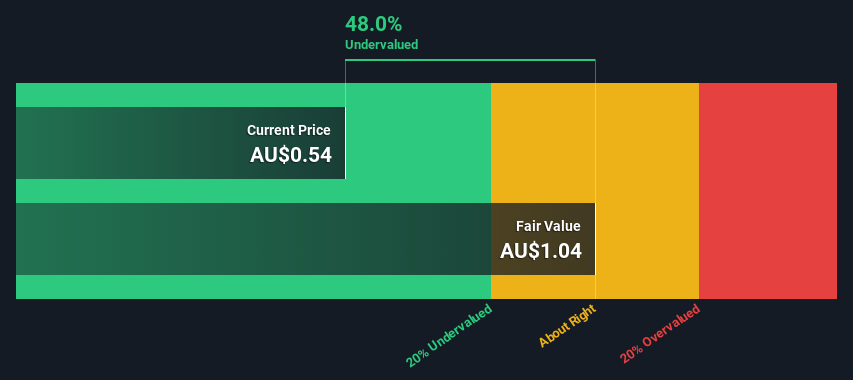- Australia
- /
- Specialty Stores
- /
- ASX:CCX
City Chic Collective Limited (ASX:CCX) Shares Could Be 48% Below Their Intrinsic Value Estimate

Key Insights
- City Chic Collective's estimated fair value is AU$1.04 based on 2 Stage Free Cash Flow to Equity
- City Chic Collective's AU$0.54 share price signals that it might be 48% undervalued
- The AU$0.56 analyst price target for CCX is 46% less than our estimate of fair value
Today we'll do a simple run through of a valuation method used to estimate the attractiveness of City Chic Collective Limited (ASX:CCX) as an investment opportunity by taking the expected future cash flows and discounting them to today's value. This will be done using the Discounted Cash Flow (DCF) model. Models like these may appear beyond the comprehension of a lay person, but they're fairly easy to follow.
Remember though, that there are many ways to estimate a company's value, and a DCF is just one method. If you still have some burning questions about this type of valuation, take a look at the Simply Wall St analysis model.
See our latest analysis for City Chic Collective
The Model
We use what is known as a 2-stage model, which simply means we have two different periods of growth rates for the company's cash flows. Generally the first stage is higher growth, and the second stage is a lower growth phase. To begin with, we have to get estimates of the next ten years of cash flows. Where possible we use analyst estimates, but when these aren't available we extrapolate the previous free cash flow (FCF) from the last estimate or reported value. We assume companies with shrinking free cash flow will slow their rate of shrinkage, and that companies with growing free cash flow will see their growth rate slow, over this period. We do this to reflect that growth tends to slow more in the early years than it does in later years.
A DCF is all about the idea that a dollar in the future is less valuable than a dollar today, so we need to discount the sum of these future cash flows to arrive at a present value estimate:
10-year free cash flow (FCF) estimate
| 2024 | 2025 | 2026 | 2027 | 2028 | 2029 | 2030 | 2031 | 2032 | 2033 | |
| Levered FCF (A$, Millions) | -AU$1.67m | AU$13.3m | AU$17.8m | AU$17.9m | AU$18.1m | AU$18.3m | AU$18.6m | AU$18.9m | AU$19.2m | AU$19.6m |
| Growth Rate Estimate Source | Analyst x3 | Analyst x3 | Analyst x2 | Est @ 0.49% | Est @ 0.97% | Est @ 1.30% | Est @ 1.54% | Est @ 1.70% | Est @ 1.81% | Est @ 1.89% |
| Present Value (A$, Millions) Discounted @ 8.2% | -AU$1.5 | AU$11.3 | AU$14.1 | AU$13.1 | AU$12.2 | AU$11.4 | AU$10.7 | AU$10.1 | AU$9.5 | AU$8.9 |
("Est" = FCF growth rate estimated by Simply Wall St)
Present Value of 10-year Cash Flow (PVCF) = AU$100m
The second stage is also known as Terminal Value, this is the business's cash flow after the first stage. The Gordon Growth formula is used to calculate Terminal Value at a future annual growth rate equal to the 5-year average of the 10-year government bond yield of 2.1%. We discount the terminal cash flows to today's value at a cost of equity of 8.2%.
Terminal Value (TV)= FCF2033 × (1 + g) ÷ (r – g) = AU$20m× (1 + 2.1%) ÷ (8.2%– 2.1%) = AU$328m
Present Value of Terminal Value (PVTV)= TV / (1 + r)10= AU$328m÷ ( 1 + 8.2%)10= AU$149m
The total value, or equity value, is then the sum of the present value of the future cash flows, which in this case is AU$249m. The last step is to then divide the equity value by the number of shares outstanding. Compared to the current share price of AU$0.5, the company appears quite good value at a 48% discount to where the stock price trades currently. The assumptions in any calculation have a big impact on the valuation, so it is better to view this as a rough estimate, not precise down to the last cent.

Important Assumptions
We would point out that the most important inputs to a discounted cash flow are the discount rate and of course the actual cash flows. Part of investing is coming up with your own evaluation of a company's future performance, so try the calculation yourself and check your own assumptions. The DCF also does not consider the possible cyclicality of an industry, or a company's future capital requirements, so it does not give a full picture of a company's potential performance. Given that we are looking at City Chic Collective as potential shareholders, the cost of equity is used as the discount rate, rather than the cost of capital (or weighted average cost of capital, WACC) which accounts for debt. In this calculation we've used 8.2%, which is based on a levered beta of 1.222. Beta is a measure of a stock's volatility, compared to the market as a whole. We get our beta from the industry average beta of globally comparable companies, with an imposed limit between 0.8 and 2.0, which is a reasonable range for a stable business.
SWOT Analysis for City Chic Collective
- Debt is not viewed as a risk.
- No major weaknesses identified for CCX.
- Forecast to reduce losses next year.
- Has sufficient cash runway for more than 3 years based on current free cash flows.
- Trading below our estimate of fair value by more than 20%.
- Significant insider buying over the past 3 months.
- Revenue is forecast to decrease over the next 2 years.
Next Steps:
Whilst important, the DCF calculation shouldn't be the only metric you look at when researching a company. The DCF model is not a perfect stock valuation tool. Rather it should be seen as a guide to "what assumptions need to be true for this stock to be under/overvalued?" For example, changes in the company's cost of equity or the risk free rate can significantly impact the valuation. Why is the intrinsic value higher than the current share price? For City Chic Collective, we've put together three additional aspects you should further research:
- Risks: As an example, we've found 1 warning sign for City Chic Collective that you need to consider before investing here.
- Management:Have insiders been ramping up their shares to take advantage of the market's sentiment for CCX's future outlook? Check out our management and board analysis with insights on CEO compensation and governance factors.
- Other High Quality Alternatives: Do you like a good all-rounder? Explore our interactive list of high quality stocks to get an idea of what else is out there you may be missing!
PS. Simply Wall St updates its DCF calculation for every Australian stock every day, so if you want to find the intrinsic value of any other stock just search here.
If you're looking to trade City Chic Collective, open an account with the lowest-cost platform trusted by professionals, Interactive Brokers.
With clients in over 200 countries and territories, and access to 160 markets, IBKR lets you trade stocks, options, futures, forex, bonds and funds from a single integrated account.
Enjoy no hidden fees, no account minimums, and FX conversion rates as low as 0.03%, far better than what most brokers offer.
Sponsored ContentNew: AI Stock Screener & Alerts
Our new AI Stock Screener scans the market every day to uncover opportunities.
• Dividend Powerhouses (3%+ Yield)
• Undervalued Small Caps with Insider Buying
• High growth Tech and AI Companies
Or build your own from over 50 metrics.
Have feedback on this article? Concerned about the content? Get in touch with us directly. Alternatively, email editorial-team (at) simplywallst.com.
This article by Simply Wall St is general in nature. We provide commentary based on historical data and analyst forecasts only using an unbiased methodology and our articles are not intended to be financial advice. It does not constitute a recommendation to buy or sell any stock, and does not take account of your objectives, or your financial situation. We aim to bring you long-term focused analysis driven by fundamental data. Note that our analysis may not factor in the latest price-sensitive company announcements or qualitative material. Simply Wall St has no position in any stocks mentioned.
About ASX:CCX
City Chic Collective
Operates as a retailer of plus-size women’s apparel, footwear, and accessories in Australia, New Zealand, and the United States.
Flawless balance sheet and undervalued.
Similar Companies
Market Insights
Community Narratives



